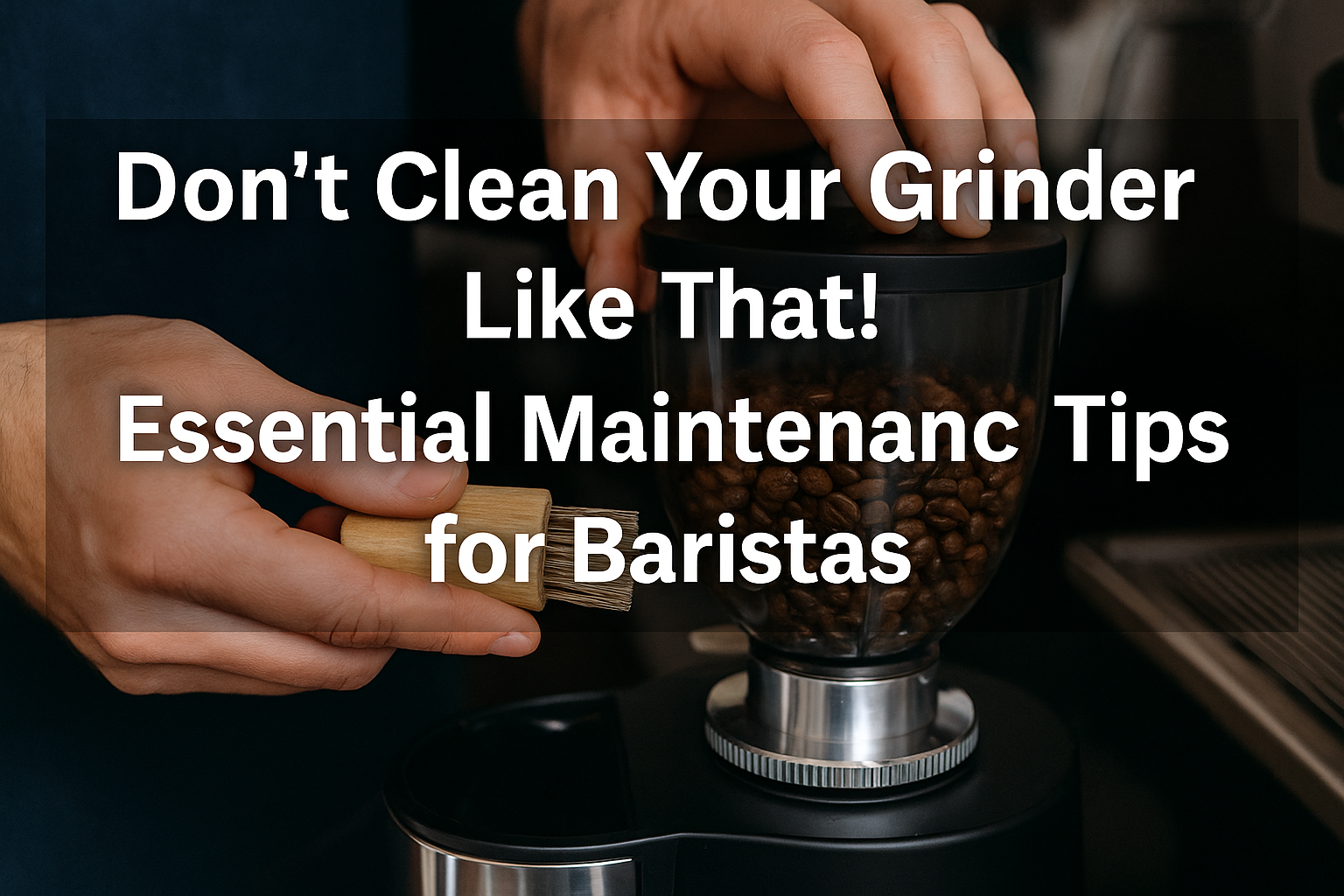When you’re new to the world of coffee, cleaning the grinder might seem like a simple task. Just open it, wipe it down, and you’re done, right? Not quite.
The grinder is one of the most important tools in a barista’s station, and poor maintenance can lead to bad coffee, equipment damage, or even safety issues.
Let’s break down the most common cleaning mistakes and show you how to properly care for this essential piece of gear.
Why Cleaning the Grinder Matters More Than You Think
Your grinder doesn’t just grind beans — it directly influences the flavor of every shot you pull. Old coffee oils, stale grinds, and dust buildup can ruin the taste of your espresso or filter coffee.
A dirty grinder leads to:
- Inconsistent grind size
- Rancid flavors
- Blockages or jams
- Increased wear on the burrs
For a barista, understanding and respecting grinder maintenance isn’t optional — it’s part of the craft.
Mistake #1: Using Water or Wet Cloths Inside the Grinder
One of the most dangerous mistakes a new barista can make is using water to clean the grinder’s burrs or internal parts. Water and grinders do not mix.
Moisture can:
- Cause rust on metal burrs
- Lead to mold growth in hidden areas
- Short-circuit electrical components
- Create compacted clumps of coffee that block the chute
Always clean the grinder dry. Use a soft brush, vacuum, or dry cloth. Never spray, soak, or wipe with wet tools unless you’re cleaning removable plastic parts that are safe to wash — and only if completely dried before reassembling.
Mistake #2: Not Cleaning Often Enough
Many beginner baristas think that if the grinder looks clean on the outside, it’s clean enough. But inside, coffee particles build up fast — especially in busy coffee shops.
If you’re not cleaning daily or at least weekly (depending on usage), your grinder is likely holding onto old oils and stale grounds. These will affect taste and smell.
At a minimum, grinders should be:
- Dusted daily: Clear the chute and wipe accessible surfaces.
- Deep-cleaned weekly: Remove the hopper, vacuum grinds, clean burrs.
- Disassembled and inspected monthly: Check for wear and deep oil buildup.
Make it part of your closing routine and treat it with the same importance as the espresso machine.
Mistake #3: Ignoring the Burrs
The burrs are the heart of the grinder, and new baristas often overlook them. Over time, burrs get coated with fine particles and oils that cause buildup and alter performance.
Dirty burrs will:
- Produce uneven grinds
- Cause your espresso to taste off
- Make grinder motors work harder
Use a dedicated grinder brush or compressed air to gently remove debris from the burrs. Some cafes use grinder cleaning pellets — food-safe products designed to absorb oils and clean without disassembly.
Check with your manager or grinder manufacturer before using them, as not all grinders are compatible.
Mistake #4: Reassembling It Incorrectly
Taking apart a grinder sounds easy — until it’s time to put it back together. A common beginner mistake is misaligning the burrs or forgetting a washer or screw.
This can lead to:
- Grind size inconsistencies
- Damage to the motor or burrs
- A grinder that won’t even start
When disassembling, take photos of each step. Label the parts, and keep screws in order. Always consult the user manual or watch a video guide for your specific model.
If you feel unsure, ask a more experienced colleague for supervision the first few times.
Mistake #5: Leaving Beans in the Hopper Overnight
It’s tempting to leave beans in the hopper for the next morning shift, but this habit can cause stale-tasting coffee.
Beans exposed to air and light degrade quickly. Oils begin to oxidize, affecting flavor, especially in lighter roasts. It also attracts insects and moisture.
At the end of your shift, empty the hopper, store beans in an airtight container, and wipe out any residual particles.
Fresh beans mean better coffee. Always.
Mistake #6: Forgetting to Clean the Doser or Grounds Chamber
On doser grinders (less common today but still in use), many beginners forget to clean the chamber where ground coffee collects. This space can hold grinds from hours ago — or worse, from yesterday.
Old grinds are bitter, stale, and can ruin your perfectly extracted shot.
For grinders with dosers or grounds chambers:
- Empty and wipe them regularly during the day
- Clean them thoroughly during your shift close
- Use a small brush to clear any stuck particles
If you use a doserless grinder, make sure to clean the chute where coffee exits. It builds up over time, too.
Mistake #7: Not Checking the Hopper and Its Seal
The hopper is often overlooked. New baristas may clean the bottom but forget to clean under the hopper, where oils can collect.
A dirty hopper can attract pests, leave oily residue, or develop an unpleasant smell. Plus, if the seal between the hopper and the grinder isn’t properly seated, beans can get stuck or fall out unevenly.
To clean it properly:
- Remove the hopper carefully
- Wash it with warm, soapy water
- Dry it completely before replacing it
- Inspect the seal for wear or cracks
If your grinder is used for flavored coffees, clean the hopper even more frequently — oils and sugars from flavorings build up fast.
How to Properly Clean a Grinder — Step by Step
Here’s a simple and safe process that works for most commercial grinders:
- Turn off and unplug the grinder
Always make sure the machine is off and disconnected from power. - Remove all beans
Empty the hopper and run the grinder to clear out any remaining grounds. - Take off the hopper and wash it
Clean it with mild soap and water. Let it dry fully. - Brush the burrs and grind chamber
Use a grinder brush or soft tool. Avoid metal or anything that could scratch the surface. - Vacuum out fine particles
Use a small vacuum or a nozzle to pull out any stubborn grounds. - Wipe the body and buttons
Use a microfiber cloth to remove smudges, oils, and dust. - Reassemble carefully
Refer to your photos or manual. Test the grinder before loading beans again. - Log your cleaning
Many cafes keep a cleaning log. This shows professionalism and helps you stay accountable.
Bonus Tip: Know Your Grinder Model
Each grinder is different. A Mazzer has different parts and procedures than a Baratza or Mahlkönig. Don’t assume — read the manual or search for videos from the manufacturer.
If you’re working in a specialty café, ask the head barista to walk you through your specific grinder. The better you know it, the better your results.
Cleaning Isn’t Boring — It’s Professionalism
In coffee culture, we often glorify latte art, signature drinks, and cool machines. But behind every great barista is a solid cleaning routine. It’s a sign of respect — for your tools, your customers, and your craft.
When you clean your grinder correctly, you ensure consistency in every cup. You save your café money by extending the life of your equipment. And you gain trust from your team by showing that you care about every detail.
Professionalism starts with the basics, and cleaning is one of the most powerful habits you can build.

Marcelo Rodrigues is a passionate barista with over 7 years of experience in specialty coffee. He’s worked in top cafés, led barista training sessions, and now shares practical tips to help beginners and coffee lovers improve their skills. Through this blog, Marcel makes the world of coffee more accessible—one cup at a time.

